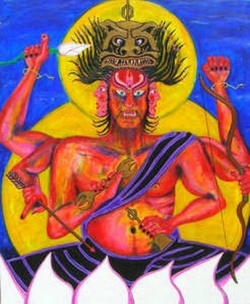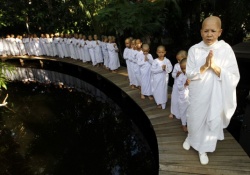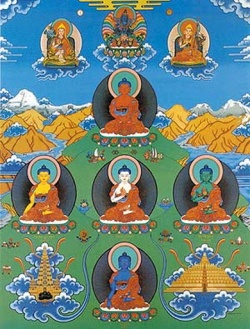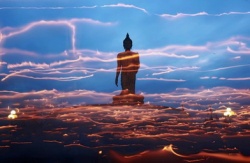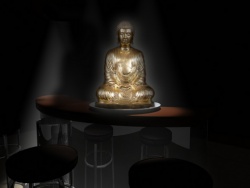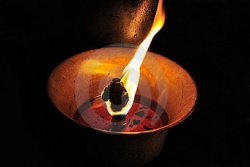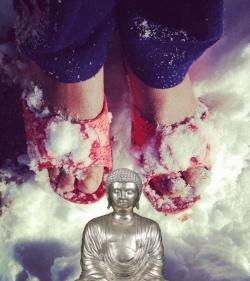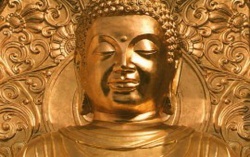Shramana
The ' Shramana (Skt. Śramaṇa; Pāli. samaṇa) was an ancient Indian religious movement, parallel to, but separate from Vedic Hinduism, although the term Shramana has been mentioned in several later Hindu texts such as Brihadaranyaka Upanishad. The Shramana tradition gave rise to Jainism, Buddhism, and some nāstika schools of Hinduism like Cārvāka, Ājīvika. Some popular concepts in all major Indian religions such as Yoga, , saṃsāra (the cycle of birth and death) and moksha (liberation from that cycle), according to few scholars.
shramana
沙門 (Skt; Pali samana; Jpn shamon )
A seeker of the way. In India, the word originally referred to any ascetic, recluse, mendicant, or other religious practitioner who renounced secular life and left home to seek the truth. Later it came to mean chiefly one who renounces the world to practice Buddhism.
Etymology and origin
The Pāli samaṇa and the Sanskrit Śramaṇa refer to renunciate ascetic traditions from the middle of the 1st millennium BCE. They were individual, experiential and free-form traditions, independent of society; and in religious competition with Brahmin priests, who as opposed to Shramanas, stressed mastery of texts and performing rituals.
The Pāli samaṇa and the Sanskrit Śramaṇa are postulated to be derived from the verbal root śram, meaning "to exert effort, labor or to perform austerity". "Śramaṇa" thus means "one who strives" or "laborer" in Sanskrit and Pali. The term was applied to those who wholeheartedly practiced toward enlightenment, and was used for monks. The Shramana traditions are best captured in the term parivrajaka meaning, a homeless wanderer. The history of wandering monks in ancient India is partly untraceable. The term 'parivrajaka' was perhaps applicable to all the peripatetic monks of India.
Indian grammarians use the terms 'Sharamana' and 'Brahmin' to illustrate bitter opponents whose differences came from varying religious models. Part of the Shramana tradition remained outside the Hindu fold by rejecting the authority of the Vedas; with the Jains, Buddhists, Ajivikas, and other religious groups developing as a result of this rejection. Part of the Shramana tradition was absorbed into Hindu dharma literature with a place for a renunciate sanyasi in it, in the four stages (ashramas) of life.
One of the earliest uses of the word is in the Hindu text Taittiriya Aranyaka (2-7-1) with the meaning of 'performer of austerities'. Buddhist commentaries associate the word's etymology with the quieting (samita) of evil (pāpa) as in the following phrase from the Dhammapada, verse 265: samitattā pāpānaŋ ʻsamaṇoʼ ti pavuccati ("someone who has pacified evil is called samaṇa").
Śramaṇa movement
There are only two references to the word Sramana in vedic literature. One is in Brihadaranyaka Upanishad where it is placed next to the term 'tapasa', indicating that the Shramana like the tapasa was a class of mendicants. It has been argued renunciation was not uncommon to the Vedic society, with Yatis, Munis, Shramanas quoted amongst earliest renouncers. In the pastoral cultures of Vedic people, the renouncer Munis and Yatis were looked down upon. The renouncers meditated upon death, link between births and death conditioned by attachment to desire. These themes surface in vedic literature for the first time in the Upanishads. After passing through henotheism and pantheism, the anthropomorphism of Vedas entered the period of monism in the Upanishadic period.
It is in the Upanishadic period that theories identifiable with Shramanas come in direct contact with brahmanical ideals. According to Ananda Guruge, a renowned Buddhist leader, the Sramana movement impacted Vedic education through the Upanishads, with debate and discussion replacing parrot-like repetition of the Vedas. Many Upanishads compile contradictory positions where the favorite style of debate is to pose questions until the other cannot answer. The infinite regress notwithstanding, upanishadic arguments do not involve finding logical contradictions in opposing doctrines. The heterogenous nature of Upanishads shows infusions of both social and philosophical elements, pointing to evolution of new doctrines from non-brahmanical sources. While the Upanishadic doctrines of Brahman and Atman can be traced back to the Vedas and Brahmanas, the doctrines of Transmigration (as punarjanma), Karma (as action), and Emancipation (as moksha) do not follow with consistency from vedic traditions, and are fundamental to the Shramana religions.
Several śramaṇa movements are known to have existed in India, even before the 6th century BCE, and these influenced both the Astika and the Nastika traditions of Indian philosophy. It was as a Shramana that the Buddha left his father's palace and practised austerities. The Brahmajāla Sutta mentions many śramaṇas with whom Buddha disagreed. Some scholars opine Sramanas of Jaina tradition were widespread in the Indus Valley, with the relics of Indus Valley civilization representing Jaina culture, like the standing nude male figures (Jaina Kayotsarga), idols in Padmasana and images with serpent-heads, and the Bull symbol of Vrshabadeva. However, other scholars opine the Sramana cultures arose and flourished in the Gangetic areas, rather than the Indus Valley. Additionally, some scholars opine the term Shramana appears in texts of the Brahmanas as a religious order other than the Vedic (i.e., Astika) traditions,. The Shramana tradition of the Jaina religion is considered the oldest of the non-Aryan group, as an independent pre-Buddhist religion (Bhaskar, 1972), and is suggested to have existed before the Brahmin cult. From rock edicts, it is found that both Brahmans as well as Shramana Buddhist ascetics enjoyed equal sanctity.
Though Shramana traditions are associated with ascetism, some shramana traditions were, in fact, peculiar as materialists, in the sense they preached a worldly existence and carried denunciation of brahmanical orthodoxy to the extreme. The Shramana traditions included a range of beliefs, such as the Cārvākas, who on one end of the spectrum lived a luxurious life, to the Jainas, who on the other hand, developed a theory of extreme self-mortification. Some Shramanas were openly critical of the sacrificial traditions of the Brahmins and the concepts of Karma, claiming them to be simply a swindle --
'Don't believe in them - when you're dead, you're dead. All their talk of Karman is nonsense. One of the materialists said, 'If a man went north of the Ganges and murdered, and tortured, and stole, and plundered and set buildings on fire, he would make no bad Karman. If another man went south of the Ganges and gave in charity, and helped the weak and healed the sick, he would make no good Karman. You live as a combination of the four elements, but when you die, everything is finished. So borrow money and live as happily as you can, for when you're dead, they can't pursue you.'
The Cārvāka Lokayatas asserted a purely naturalist position, claiming the world consists of merely working out the elements.
Yet another conflict can be found in the works of Dharmakirti, the eminent 7th-century CE Buddhist logician from Nalanda:
vedapramanyam kasyacit kartrvadah/ snane dharmeccha jativadavalepah// santaparambhah papahanaya ceti/ dhvastaprajnanam pancalirigani jadye
The unquestioned authority of the vedas; the belief in a world-creator; the quest for purification through ritual bathings; the arrogant division into castes; the practice of mortification to atone for sin; - these five are the marks of the crass stupidity of witless men.
While authority of vedas, belief in a creator, path of ritualism and social system of heredity ranks, made up the cornerstones of brahminal schools, the path of asceticism was the main characteristic of all the heterodox schools collectively called the Shramanas.
It was in Shramana traditions that concepts of Karma and Samsara became central themes of debate., and it has been suggested that this may have been introduced into the mainstream by Kshatriyas. In Jainism, Karma is based on materialist element philosophy, where Karma is the fruit of one's action conceived as material particles which stick to a soul and keep it away from natural omniscience. The Buddha conceived Karma as a chain of causality leading to attachment of the material world and hence to rebirth. The Ajivikas of Makkhali Ghosa were a third successful movement during this time. They were fatalists and elevated Karma as inescapable fate, where a person's life goes through a chain of consequences and rebirths until it reaches its end. Some famous philosophers of that time, such as Pakkudha Kaccayana and Purana Kashyapa, denied the existence of Karma. It was indeed the creative Shramana generations of the 500 to 400 BCE, in whom Karma doctrine became the centre of attention, who set far-reaching consequences for lifestyle and thought among Indians.
In later periods, the Jains migrated towards the West and South of India and established themselves as prosperous communities in the Chalukya and Rashtrakuta courts. The Digambaras in the South could not preach against social ranks at the cost of their survival. It was suicidal for them to follow the brahmanical law-books. Therefore in the 8th century CE, Jinasena produced Jain law books in the guise of Puranas glorifying Jain Thirthankaras and declaring Varnas were not of Brahmanical origin but was promulgated by the first of the twenty-four Tirthankaras, Vrsabha, at the beginning of the present kalpa. Vrashabha prescribed Jain rites for birth, marriage, death and instituted a class of Jain-brahmans.
Śramaṇa Influences
Modern Hinduism can be regarded as a combination of Vedic and Shramana traditions as it is substantially influenced by both traditions. Among the Astika schools of Hinduism, Vedanta, Samkhya, and Yoga are early and very important philosophies that have influenced and been influenced by the Sramana philosophy, with their origins in the Indus Valley period of about 3000-2000 BCE. Yoga follows the Samkhya philosophy of liberating oneself from the grip of Prakriti (nature) through individual effort. Elaborate processes are outlined in Yoga to achieve individual liberation through breathing techniques (Pranayama), physical postures (Asanas) and meditations (Dhyana). Patanjali's Yoga sutra is one product (school) of this philosophy. Other Yogic schools and the Tantra traditions are also important derivatives and branches of the Sramana practices.
The Sramana movement later received a boost during the times of Mahavira and Buddha when Vedic ritualism had become the dominant tradition in certain parts of India. Śramaṇas adopted a path alternate to the Vedic rituals to achieve liberation, while renouncing household life. They typically engage in three types of activities: austerities, meditation, and associated theories (or views). As spiritual authorities, śramaṇa were at variance with traditional Brahmin authority. However some Brahmins joined the Sramana movement, such as Cānakya and Śāriputra . Similarly, a group of eleven Brahmins accepted Jainism of Mahavira, and become his chief disciples or Ganadharas.
With regard to Buddhism, Randall Collins opined that Buddhism was more a reform movement within the educated religious classes, composed mostly of Brahmins, than a rival movement from outside these classes, with the largest number of monks in the early movement derived from Brahmin origin, and virtually all the monks were recruited from the two upper classes of society
Mahāvīra, the 24th Jina, and Gautama Buddha were leaders of their śramaṇa orders. According to Jain literature and the Buddhist Pali Canon, there were also some other śramaṇa leaders at that time. Thus, in the Mahāparinibbāna Sutta (DN 16), a śramaṇa named Subhadda mentions:
...those ascetics, samaṇa and Brahmins who have orders and followings, who are teachers, well-known and famous as founders of schools, and popularly regarded as saints, like Pūraṇa Kassapa, Makkhali Gosāla, Ajita Kesakambalī, Pakudha Kaccāyana, Sañjaya Belaṭṭhaputta and the Nigaṇṭha Nātaputta... .
Nigaṇṭha Nātaputta (Pāli; Skt.: Nirgrantha Jñātaputra) refers to Mahāvīra . In regard to the above other teachers identified in the Pali Canon, Jain literature mentions Pūraṇa Kassapa, Makkhali Gosāla and Sañjaya Belaṭṭhaputta. (The Pali Canon is the only source for Ajita Kesakambalī and Pakudha Kaccāyana.)
Gautama Buddha regarded extreme austerities and self-mortification as useless or unnecessary in attaining enlightenment, recommending instead a "middle way" between the extremes of hedonism and self-mortification. Devadatta, a cousin of Gautama, caused a split in the Buddhist saṅgha by demanding more rigorous practices. Followers of Mahāvīra continued to practice fasting and other austerities.
The śramaṇa idea of wandering began to change early in Buddhism. The bhikṣu started living in monasteries (Pali, Skt. vihāra), at first during the rainy seasons, but eventually permanently. In medieval Jainism also, the tradition of wandering waned, but it was revived in the 19th century. Similar changes have regularly occurred in Buddhism.
Śramaṇa philosophy
Indian philosophy is a confluence of Śramaṇic (self-reliant) traditions, Bhakti traditions with worship of deities and Vedic ritualistic nature worship. These co-exist and influence each other. Śramaṇas held a view of samsara as full of suffering (or dukkha). They practiced Ahimsa and rigorous ascetism. They believed in Karma and Moksa and viewed rebirth as undesirable.
Vedics, on the contrary believe in the efficacy of rituals and sacrifices, performed by a privileged group of people, who could improve their life by pleasing certain Gods. The Sramanic ideal of mendicancy and renunciation, that the worldly life is full of suffering and that emancipation requires abandoning desires and withdrawal into a solitary contemplative life, is in stark contrast with the Brahminical ideal of an active and ritually punctuated life. Traditional Vedic belief holds that a man is born with an obligation to study the Vedas, to procreate and rear male offspring and to perform sacrifices. Only in later life may he meditate on the mysteries of life. The idea of devoting one's whole life to mendicancy seems to disparage the whole process of Vedic social life and obligations. Because the Sramanas rejected the Vedas, the Vedics labelled their philosophy as "nastika darsana" (heterodox philosophy).
Beliefs and concepts of Śramaṇa philosophies :-
Denial of creator and omnipotent Gods
Rejection of the Vedas as revealed texts
Affirmation of Karma and rebirth, Samsara and transmigration of Soul.
Affirmation of the attainment of moksa through Ahimsa, renunciation and austerities
Denial of the efficacy of sacrifices and rituals for purification.
Rejection of the caste system
Ultimately, the sramana philosophical concepts like ahimsa, karma, re-incarnation, renunciation, samsara and moksa were accepted and incorporated by the Brahmins in their beliefs and practices, e.g. by abandoning the sacrifice of animals. According to Gavin Flood, concepts like karmas and reincarnation entered mainstream brahaminical thought from the sramana or the renounciant traditions. According to D. R. Bhandarkar, the Ahimsa dharma of the sramanas made an impression on the followers of Brahamanism and their law books and practices.
Following are the two main schools of Sramana Philosophy that have continued since ancient times in India:
Jain philosophy
Main article: Jain philosophy
Further information: Anekantavada, Syādvāda, and Jainism and non-creationism
Jainism derives its philosophy from the teachings and lives of the twenty-four Tirthankaras, of whom Mahavira was the last. Acharyas Umasvati (Umasvami), Kundakunda, Haribhadra, Yaśovijaya Gaṇi and others further developed and reorganized Jain philosophy in its present form. The distinguishing features of Jain philosophy are its belief in the independent existence of soul and matter, predominance of karma, the denial of a creative and omnipotent God, belief in an eternal and uncreated universe, a strong emphasis on non-violence, an accent on relativity and multiple facets of truth, and morality and ethics based on liberation of the soul. The Jain philosophy of Anekantavada and Syādvāda, which posits that the truth or reality is perceived differently from different points of view, and that no single point of view is the complete truth, have made very important contributions to ancient Indian philosophy, especially in the areas of skepticism and relativity.
Buddhist philosophy
Buddhist philosophy is a system of doctrines based on the teachings of Siddhartha Gautama, (480-400 BCE), the son of a chieftain of the Sakya tribe, later known as the Buddha. The Buddha found a Middle Way that ameliorated the extreme asceticism found in the Sramana religions. Buddhism is a non-theistic philosophy, which is especially concerned with dependent origination and sunyata.
Usage of "Śramaṇa" in Jain texts
This article improperly uses one or more religious texts as primary sources without referring to secondary sources that critically analyze them. Please help improve this article by adding references to reliable secondary sources, with multiple points of view. (June 2013)
Jain monastics are known as Śramaṇas, while lay practitioners are called shravakas. The religion or code of conduct of the monks is known as Śramaṇa Dharma. Jain canons like Ācāranga Sūtra and other later texts contain many references to Sramanas. One verse defines a good Śramaṇa:
Disregarding (all calamities) he lives together with clever monks, insensitive to pain and pleasure, not hurting the movable and immovable (beings), not killing, bearing all: so is described the great sage, a good Sramana.
The chapter on renunciation contains a Śramaṇa vow of non-possession:
I shall become a Śramaṇa who owns no house, no property, no sons, no cattle, who eats what others give him; I shall commit no sinful action; Master, I renounce to accept anything that has not been given.' Having taken such vows, (a mendicant) should not, on entering a village or free town, take himself, or induce others to take, or allow others to take, what has not been given.
Acaranga Sutra gives three names of Mahavira, the twenty fourth Tirthankara, one of which was Śramaṇa:
The Venerable ascetic Mahavira belonged to the Kasyapa gotra. His three names have thus been recorded by tradition: by his parents he was called Vardhamana, because he is devoid of love and hate; (he is called) Sramana (i.e. ascetic), because he sustains dreadful dangers and fears, the noble nakedness, and the miseries of the world; the name Venerable Ascetic Mahavira has been given to him by the gods.
Another Jain canon, Sūtrakrtanga describes the Śramaṇa as an ascetic who has taken Mahavrata, the five great vows:
He is a Śramaṇa for this reason that he is not hampered by any obstacles, that he is free from desires, (abstaining from) property, killing, telling lies, and sexual intercourse; (and from) wrath, pride, deceit, greed, love, and hate: thus giving up every passion that involves him in sin, (such as) killing of beings. (Such a man) deserves the name of a Śramaṇa, who subdues (moreover) his senses, is well qualified (for his task), and abandons his body.
In a disputations with other heretical teachers, prince Ardraka, who became disciple to Mahavira, tells Makkhali Gosala the qualities of Sramanas:
He who (teaches) the great vows (of monks) and the five small vows (of the laity 3), the five Âsravas and the stoppage of the Âsravas, and control, who avoids Karman in this blessed life of Śramaṇas, him I call a Śramaṇa.
Influence on Hinduism
Sramana gave rise to several elements which were subsequently adopted by several Indian religions. The concept of the cycle of birth and death, the concept of samsara, the concept of liberation and yoga are ultimately from Sramana. The Hindu ashrama system of life was an attempt to institutionalize Shramana ideals within the Brahmanical social structure. The Shramana movement also influenced the Aranyakas and Upanishads in the Brahmanical tradition.
Śramaṇa in Western literature
Various references to "śramaṇas", with the name more or less distorted, have been handed down in Western literature about India.
Nicolaus of Damascus (c. 10 CE)
Nicolaus of Damascus wrote an account of an embassy sent by an Indian king "named Pandion (Pandyan kingdom?) or, according to others, Porus" to Caesar Augustus around 13 CE. He met with the embassy at Antioch. The embassy was bearing a diplomatic letter in Greek, and one of its members was a "Sarmano" (Σαρμανο) who burnt himself alive in Athens to demonstrate his faith. The event made a sensation and was quoted by Strabo and Dio Cassius . A tomb was made to the "Sarmano", still visible in the time of Plutarch, which bore the mention "ΖΑΡΜΑΝΟΧΗΓΑΣ ΙΝΔΟΣ ΑΠΟ ΒΑΡΓΟΣΗΣ" (Zarmanochēgas indos apo Bargosēs – The sramana master from Barygaza in India).
Clement of Alexandria (150-211)
Clement of Alexandria makes several mentions of the Sramanas, both in the context of the Bactrians and the Indians:
Thus philosophy, a thing of the highest utility, flourished in antiquity among the barbarians, shedding its light over the nations. And afterwards it came to Greece. First in its ranks were the prophets of the Egyptians; and the Chaldeans among the Assyrians; and the Druids among the Gauls; and the Samanaeans among the Bactrians ("Σαμαναίοι Βάκτρων"); and the philosophers of the Celts; and the Magi of the Persians, who foretold the Saviour's birth, and came into the land of Judaea guided by a star. The Indian gymnosophists are also in the number, and the other barbarian philosophers. And of these there are two classes, some of them called Sarmanae ("Σαρμάναι"), and Brahmanae ("Βραχμαναι").
To Clement of Alexandria, "Bactrians" apparently means "Oriental Greek", as in a passage of the Stromata:
It was after many successive periods of years that men worshipped images of human shape, this practice being introduced by Artaxerxes, the son of Darius, and father of Ochus, who first set up the image of Aphrodité Anaitis at Babylon and Susa; and Ecbatana set the example of worshipping it to the Persians; the Bactrians, to Damascus and Sardis.
Porphyry (233-305)
Porphyry extensively describes the habits of the Sramanas (whom he calls Samanaeans) in his "On Abstinence from Animal Food" Book IV . He says his information was obtained from "the Babylonian Bardesanes, who lived in the times of our fathers, and was familiar with those Indians who, together with Damadamis, were sent to Caesar"
For the polity of the Indians being distributed into many parts, there is one tribe among them of men divinely wise, whom the Greeks are accustomed to call Gymnosophists. But of these there are two sects, over one of which the Brahmins preside, but over the other the Samanaeans. The race of the Brahmins, however, receive divine wisdom of this kind by succession, in the same manner as the priesthood. But the Samanaeans are elected, and consist of those who wish to possess divine knowledge.
All the Brahmins originate from one stock; for all of them are derived from one father and one mother. But the Samanaeans are not the offspring of one family, being, as we have said, collected from every nation of Indians...
On entering the order:
The Samanaeans are, as we have said, elected. When, however, any one is desirous of being enrolled in their order, he proceeds to the rulers of the city; but abandons the city or village that he inhabited, and the wealth and all the other property that he possessed. Having likewise the superfluities of his body cut off, he receives a garment, and departs to the Samanaeans, but does not return either to his wife or children, if he happens to have any, nor does he pay any attention to them, or think that they at all pertain to him. And, with respect to his children indeed, the king provides what is necessary for them, and the relatives provide for the wife. And such is the life of the Samanaeans. But they live out of the city, and spend the whole day in conversation pertaining to divinity. They have also houses and temples, built by the king".
On life and death:
They are so disposed with respect to death, that they unwillingly endure the whole time of the present life, as a certain servitude to nature, and therefore they hasten to liberate their souls from the bodies [with which they are connected]. Hence, frequently, when they are seen to be well, and are neither oppressed, nor driven to desperation by any evil, they depart from life.
Śramaṇa in contemporary Western culture
German novelist Hermann Hesse, long interested in Eastern, especially Indian, spirituality, wrote Siddhartha, in which the main character becomes a Samana upon leaving his home (where he was a Brahmin).
